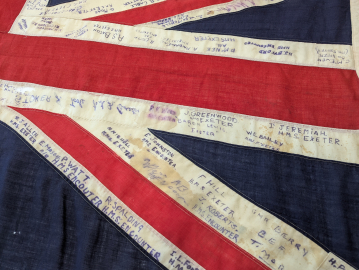VJ Day, HMS Exeter and a uniquely important Union Jack
- View news filtered by: Second World War
- View news filtered by: Culture, Sport and Leisure
- View news filtered by: Remembrance
- View news filtered by type: Blog

Please read on for an insight into VJ Day, a very special Union Jack flag and an exclusive opportunity with the National Museum of the Royal Navy.
15 August 2025 is the 80th anniversary of VJ Day, commemorating the surrender of Japan during the Second World War. While many took Germany’s surrender in May 1945 as the end of the War, what awaited was three more gruelling months of war in the Pacific Theatre; not to mention the suffering of those in Japanese Prisoner of War (POW) camps, which for many lasted beyond the Japanese surrender.
Life in these camps was notoriously hard; many internees were used for labour, starved and beaten. It can’t have helped those still interned that by May 1945 many back home were celebrating what they saw as the end of the War. One such POW camp was Kampong Makassar, on the island of Java, today near Jakarta in Indonesia. This camp housed many Dutch civilians, alongside members of the Royal Navy, including the surviving crew of HMS Exeter and HMS Encounter. But how did they end up there?
Japan had set its sights on the Dutch East Indies early in the War. This colony was rich in oil vital for the Japanese war effort and geographically close. At this time, it was the fourth-largest oil exporter in the world. HMS Exeter was one of the ships assigned to defend the Dutch East Indies from invading Japanese forces. During the Battle of the Java Sea in February 1942, Exeter was badly damaged and needed to be escorted from the battle before she was sunk entirely. Exeter fled to Ceylon (modern day Sri Lanka) and nearly made the journey before being spotted and fatally damaged by Japanese forces. The Japanese victory during the battle effectively ended any real Allied resistance to the invasion of the Dutch East Indies and it was captured by early March.
The 652 survivors of HMS Exeter were captured by Japanese forces and interned at Makassar. It was a similar story for those of HMS Encounter which was destroyed during the battle. Towards the end of the war, Dutch civilians that had lived on the island of Java were also interned at the camp. Life in Makassar was incredibly hard. With disease common and food rare, 152 of the crew died in the camp before they could be rescued.
The National Museum of the Royal Navy holds a vital artefact from this story, an unassuming Union Jack. This flag was dropped on Kampong Makassar by Flight Sergeant Anthony Kane of the Australian Air Force during a routine supply drop in September 1945, perhaps as a symbol that while the war in Europe was over they had not been forgotten. Some of the Royal Navy personnel in the camp signed the flag, each writing their name and the ship they had belonged to.
As seen on the BBC, one name, ‘R K Wood’ was spotted by a family member who came down to see the flag for himself, a pertinent reminder of his family’s service. Now, free exclusively for visitors with an Ultimate Explorer ticket, you can see the Union Jack in-person and get close to this unique piece of Second World War history.
An Ultimate Explorer ticket can be purchased on the National Museum of the Royal Navy website, and bookings for this event are open now on the National Museum of the Royal Navy website.